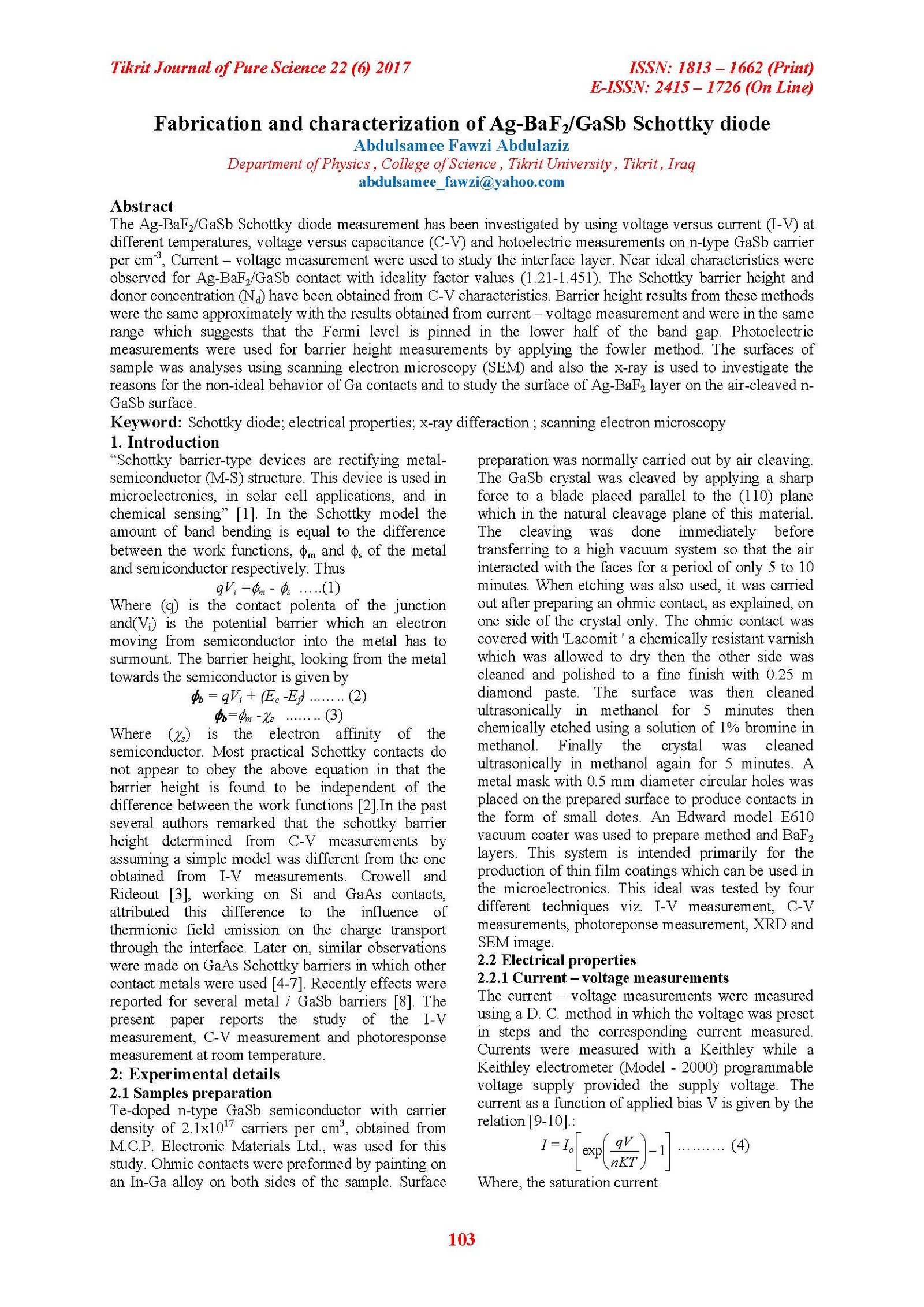Fabrication and characterization of Ag-BaF2/GaSb Schottky diode
Main Article Content
Abstract
The Ag-BaF2/GaSb Schottky diode measurement has been investigated by using voltage versus current (I-V) at different temperatures, voltage versus capacitance (C-V) and hotoelectric measurements on n-type GaSb carrier per cm-3, Current – voltage measurement were used to study the interface layer. Near ideal characteristics were observed for Ag-BaF2/GaSb contact with ideality factor values (1.21-1.451). The Schottky barrier height and donor concentration (Nd) have been obtained from C-V characteristics. Barrier height results from these methods were the same approximately with the results obtained from current – voltage measurement and were in the same range which suggests that the Fermi level is pinned in the lower half of the band gap. Photoelectric measurements were used for barrier height measurements by applying the fowler method. The surfaces of sample was analyses using scanning electron microscopy (SEM) and also the x-ray is used to investigate the reasons for the non-ideal behavior of Ga contacts and to study the surface of Ag-BaF2 layer on the air-cleaved n-GaSb surface.
Article Details

This work is licensed under a Creative Commons Attribution 4.0 International License.
Tikrit Journal of Pure Science is licensed under the Creative Commons Attribution 4.0 International License, which allows users to copy, create extracts, abstracts, and new works from the article, alter and revise the article, and make commercial use of the article (including reuse and/or resale of the article by commercial entities), provided the user gives appropriate credit (with a link to the formal publication through the relevant DOI), provides a link to the license, indicates if changes were made, and the licensor is not represented as endorsing the use made of the work. The authors hold the copyright for their published work on the Tikrit J. Pure Sci. website, while Tikrit J. Pure Sci. is responsible for appreciate citation of their work, which is released under CC-BY-4.0, enabling the unrestricted use, distribution, and reproduction of an article in any medium, provided that the original work is properly cited.
References
[1] I. H. Gul, A. Z. Abbasi, F. Amin, M- Anis-ur-Rechman, A. Maqsood,. J. Magn. Magn. Mater. 320 (2008) 270.
[2] S. D. Bhame and P. A. Joy, J. Phys. D: Appl. Phys. 40 (2007) 3263-3267.
[3] P. Poddar, H. Srikanth, S. A. Morrison, E. E. Carpenter, J. Magn. Magn. Mater. 288 (2005) 443-451.
[4] L. Zhao, H. Yang, X. Zho, L. Gui, S. Feng, J. Mater. Lett. 60 (2006) 1.
[5] M. M. Rashad, R. M. Mohamed, H. El-Shall. J. Mater. Pro. Tech. 198 (2008) 139 -146.
[6] Xu Feng, Zhou Xiangchun, Li Liangchao, Liu Hui and Jiang Jing,. Journal of Rare Earths. 25 (2007) 232.
[7] S. D. Bamane, P. A. Joy, Sensors and Actuators A, 137 (2007) 256.
[8] G. Engdahl, Handbook of Giant Magnetostrictive Materials (San Diego, CA: Academic) 2000.
[9] E. H. Rhoderick, R. H. Williams; Metal-Semiconductor contacts. Clarendon, Oxford., 1998.
[10] H. K. Henisch, semiconductor contacts, oxford, London, (1984)
[11] G. Eftekhari, J. Vac. Sci. Technol. B11, (1993), 1317.
[12] B. P. Ladgaonkar, P. N. Vasambekar and A. S. Vaingankar, Bull. Mater. Sci. Vol. 23. No. 2. April. 2000. PP 87-90. J. Indian Academy of Sciences
[13] M. K. Hudait, P. Venkateswarlu and S. B. Krupanidhi, solid-state Electronics, 45 (2001) 133-141.
[14] R. Padma, V. Rajagopal Reddy, Adv. Mat. Lett. 5(1) 2014, 31-38
[15] P. Chattopadhyay, B. Raychaudhuri. Solid State Electron., 35 (875, 1992.
[16] S. M. Sze, “Physics of Semiconductor Devices”, 2nd Edition, John Wiley & Sons, p245-311 (2005).
[17] Desousa pires. J. Phsica scripta 18(1978), 372.
[18] N. H. Vasoya1, V. K. Lakhani1, P. U. Sharma1, K. B. Modi, Ravi Kumar and H. H. Joshi J. Phys.: Condens. Matter 18 (2006) 8063–809.
[19] R. T. Tung, Mater. Sci. Eng. R1 (2001)35
[20] T. Hashizume and T. Saitoh, Appl. Phys. Lett. 78, (2001) 2318-2320.
